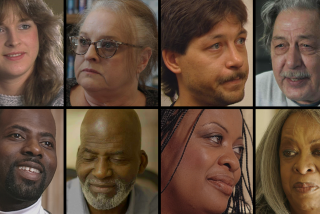Number of Inner-City Single Parents on Rise : Families: Experts see a shortage of ‘marriageable’ young black men. The situation fosters a cycle of poverty, they say.
- Share via
CHICAGO — Willie Jean Nash is a 30-year-old welfare mother of five children who, like many of her friends, has never been married.
“I’m waiting for the right man,” she said recently at a preschool center in a dismal public housing project on the South Side of Chicago. “I’m waiting for someone who has a good job and is good to the kids. But they are hard to find.”
Nash’s comments cut to the heart of one of the most dismaying problems of the black underclass in the large cities of America--an enormous and ever-growing number of families headed by single, unmarried mothers on welfare.
The number of black families headed by a single mother more than doubled from 1.3 million in 1970 to 3 million in 1987. The percentage of black families headed by mothers who had never married increased from 16% to 37%. In Illinois, where Nash lives, four in every five children born to black mothers in their early 20s are illegitimate; so are practically all children born to black teen-age mothers.
Although some analysts blame the welfare system or some kind of cultural failing among poor blacks, many sociologists believe that the cause of the disturbing phenomenon is more obvious: the shortage of marriageable males in the black underclass.
Few young men have good enough jobs to support a family; most are either out of work or in jail or at school. In sheer economic terms, analysts say, a typical young, underclass black male is usually worthless to a family. He cannot earn enough to support the family. If he marries the mother of his children anyway, analysts note, she will lose much of her welfare assistance.
“Black women, especially young black women, are facing a shrinking pool of ‘marriageable’ (i.e., economically stable) men,” according to sociologist William Julius Wilson of the University of Chicago.
Mark Testa, a colleague of Wilson at the University of Chicago, said that illegitimacy was a stigma as recently as 25 or 30 years ago.
“Women wanted to give their children a name,” Testa said in his office, less than a mile from Willie Jean Nash’s housing project. “So you would have seen higher rates of marriage to jobless men just for social reasons. That has changed now. Very few women will say that they think it’s a good idea to marry a jobless man.”
The large number of young, single mothers perpetuates a cycle of poverty. Mothers drop out of high school before they have enough training to qualify for anything but the most menial and poor-paying jobs. They often lack the maturity and the income to guide their children out of the traps of the inner city. The children grow up to become unemployed fathers and single mothers.
In a recent survey of young black men in the inner city, Testa found that half said they had become fathers before their 25th birthday. That is no different from similar surveys taken for many years.
“What has changed dramatically,” said Testa, “is the proportion who are not working and the proportion of those jobless men who fail to marry the mother of their first child. . . . Employed men were almost twice as likely to marry the mother of their first child conceived out of wedlock as were unemployed men.”
The image of the unmarried mother has convinced many Americans that the inner cities are crammed with poor young women breeding children like never before. The evidence does not bear the image out.
In fact, younger black women are having fewer children than they once did. The fertility rates of black women between the ages of 15 and 24 have plummeted since 1960, as it has for young white women. The average family on welfare had three children in 1970; by 1985, the average had dropped to two. Willie Jean Nash, with her five children, is the exception, not the rule.
Testa said that many poor black women tend to have two or perhaps three children before their mid-20s but then stop. Their birth rate is thus not much different from that of middle-class women who postpone children until they have assured themselves of a stable marriage and perhaps a career.
Moreover, black women of all ages are having about the same number of children as they did 20 years ago. The total number of black births increased from 565,000 in 1970 to only 622,000 in 1986. During the same period, the percentage of children born out of wedlock almost doubled from 38% to 61%.
“You have to keep those two facts straight,” Testa said. The big change is the dearth of marriages--not the numbers of children born to young mothers. Marriage among very young blacks is a disappearing institution.”
Climentene Jones, who works at the center attended by Nash’s children, said that she asks pregnant teen-agers why they would allow themselves to become pregnant when the reward is usually a certain sentence to extreme poverty.
“They look at you . . ,” she said. “Sometimes people feel like this is their opportunity to love something, or it makes them feel more adult. Whatever.”
“The teen pregnancy thing,” said Sister Susanne Beaton, a Roman Catholic nun who works with homeless mothers in Boston, “is nothing but a reflection of the search for love. The mothers have something that pays attention to them and that they have as their own.”
Jones said that a large number of pregnant teen-agers know very little about birth control. And, although Willie Jean Nash acknowledged having one abortion, most social workers say that abortion is almost never discussed by young pregnant black mothers.
Medicaid, the federal-state health program for the poor, does not finance abortions. In Chicago, Jones said, private abortions cost about $350, well beyond the reach of poor pregnant black teen-agers on welfare.
More to Read
Sign up for Essential California
The most important California stories and recommendations in your inbox every morning.
You may occasionally receive promotional content from the Los Angeles Times.










